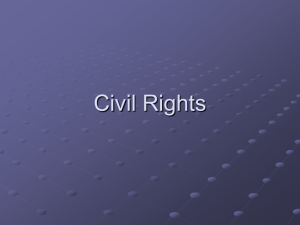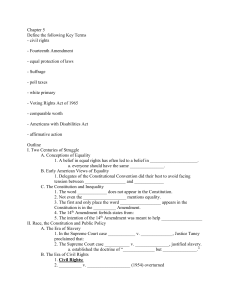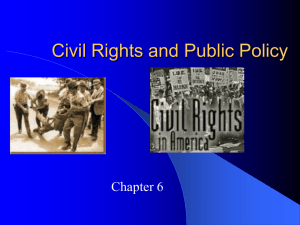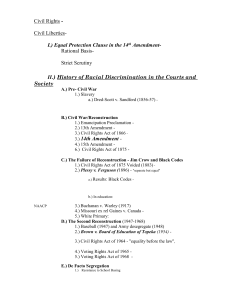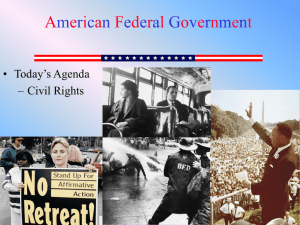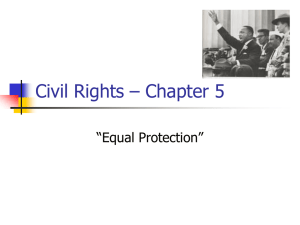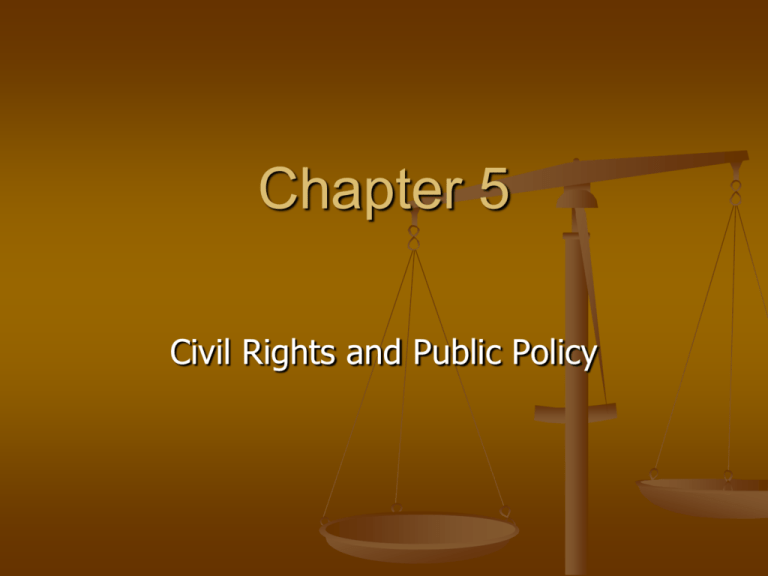
Chapter 5
Civil Rights and Public Policy
Introduction
Civil Rights
Definition: policies designed to protect people
against arbitrary or discriminatory treatment
by government officials or individuals
Racial Discrimination
Gender Discrimination
Discrimination based on age, disability,
sexual orientation and other factors
Race, the Constitution, and
Public Policy
The Constitution and Inequality
Equality is not in the original Constitution.
First mention of equality in the 14th Amendment:
“…equal protection of the laws”
The Era of Slavery
Dred Scott v. Sandford (1857)
Slaves had no rights.
Invalidated Missouri Compromise
The Civil War (1861-1865)
The 13th Amendment (Dec. 1865)
Ratified after Union won the Civil War
Outlawed slavery
Race, the Constitution, and Public
Policy
The Era of Reconstruction and Resegregation
Jim Crow or segregational laws
Plessy v. Ferguson (1896)
Relegated African Americans to separate facilities
Upheld the constitutionality of “equal but separate
accommodations”
The Era of Civil Rights
Brown v. Board of Education (1954)
Overturned Plessy
School segregation inherently unconstitutional
Integrate schools “with all deliberate speed”
Race, the Constitution, and Public
Policy
The Era of Civil Rights (continued)
Civil Rights Act of 1964
Made racial discrimination illegal in hotels,
restaurants, and other public accommodations
Forbade employment discrimination based on race
Created Equal Employment Opportunity
Commission (EEOC)
Strengthened voting right legislation
Race, the Constitution, and
Public Policy
The Right to Vote
Suffrage: the legal right to vote
15th Amendment: extended suffrage to
African Americans
Poll Taxes: small taxes levied on the right to
vote
White Primary: Only whites were allowed to
vote in the party primaries.
Race, the Constitution, and
Public Policy
Getting and Using the Right to Vote
Smith v. Allwright (1944): ended white primaries
Twenty-fourth Amendment: eliminated poll taxes for
federal elections (1964)
Harper v. Virginia State Board of Elections (1966):
found Virginia’s poll tax unconstitutional under 14th
amendment; 24th amendment prohibited poll taxes
and Supreme Court extended prohibition to the states
Voting Rights Act of 1965: helped end formal and
informal barriers to voting
Other controversial measures:
Voter I.D Laws
Reduced early voting
Eliminating voting the Sunday before the election “Souls to the Polls”
Race, the Constitution, and
Public Policy
Other Minority Groups
Native Americans
Santa Clara Pueblo v. Martinez (1978): affirmed tribal
sovereignty
Hispanic Americans
Mexican American Legal Defense and Education Fund
Asian Americans
Korematsu v. United States (1944): internment of
Japanese Americans during WWII; court rules that the need
to protect against espionage outweighed Fred Korematsu's
individual rights
(Case was never officially overturned but in 2011, the Department of Justice
filed a notice conceding it was in error.)
Women, the Constitution, and
Public Policy
The Battle for the Vote
19th Amendment: extended suffrage to women in
1920
The “Doldrums”: 1920-1960
Laws were designed to protect women, and protect
men from competition with women.
Equal Rights Amendment first introduced in Congress
in 1923; fails ratification by states (1982)
Ledbetter v. Goodyear Tire & Rubber Co. (2007)Congress passed the Lilly Ledbetter Fair Pay Act to
loosen the timeline requirements for the filing of a
discrimination suit
Women, the Constitution, and
Public Policy
Women in the Workplace
Wage Discrimination and Comparable Worth
The Civil Rights Act of 1964 banned gender
discrimination in employment.
The Supreme Court has not ruled on this issue.
Women in the Military
In January 2013, the military limited the ban on women serving in
combat positions. This decision could open more than 230,000 jobs,
many in Army and Marine infantry units, to women. Women’s
access to the Special Forces is still up in the air.
Sexual Harassment
Prohibited by Title VII of Civil Rights Act of 1964
Newly Active Groups Under the
Civil Rights Umbrella
Civil Rights and the Graying of America
Age classifications not suspect category, but fall
under rational basis test.
Civil Rights and People with Disabilities
Americans with Disabilities Act of 1990
Requiring employers and public facilities to make “reasonable
accommodations” for those with disabilities
Prohibits employment discrimination against the disabled
Newly Active Groups Under the Civil Rights Umbrella
Gay and Lesbian Rights
Lawrence v. Texas (2003)
The Court held that intimate consensual sexual conduct was
part of the liberty protected by substantive due process
under the 14th amendment
United States v. Windsor (2013)
Struck down “Definition of marriage section 3” of DOMADefense of Marriage Act (1996)
Gay Marriage
Many state constitutions amended to prohibit practice
17 States where it is legal: by court: CA, IA, CT, MA, NJ, NM;
by popular vote: MD, ME, WA; by state legislature: DE, HI,
IL, MN, NH, NY, RI, VT (D.C also allows gay marriage)
Gays in the Military
End of Don’t Ask, Don’t Tell- Gays can openly serve
Affirmative Action
Definition: a policy designed to give special attention to or
compensatory treatment of members of some previously
disadvantaged group; based on equally qualified candidates
In education
Regents of the University of California v. Bakke
(1978)
Grutter v. Bollinger (2003)
Racial set asides (quotas) were unconstitutional
Race could be considered in admissions
Race could be considered a “plus” admissions with a “strict
scrutiny” burden
Fisher v. University of Texas (2013)
The Court of Appeals did not apply “strict scrutiny” standard
so vacated and remanded case; Grutter not overturned but
established “narrowly tailored” use of race
Affirmative Action
In employment
United Steelworks v. Weber (1979)
held that Steelworks affirmative action plan could
help minority workers and did not prevent other
employees from advancing.
Adarand Constructors v. Pena (1995)
To be constitutional, affirmative action must be
“narrowly tailored” to meet a “compelling
governmental interest.”
affirmative action, in issuing government contracts,
could be used under a “strict scrutiny” standard




